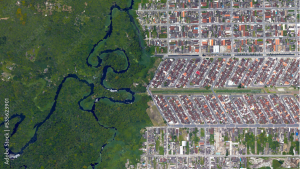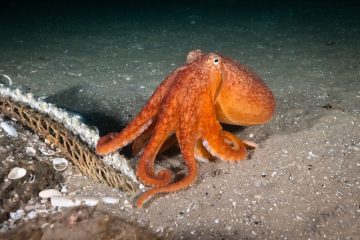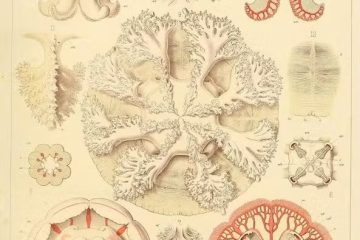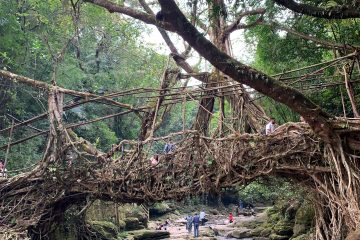The City Myth: Barad’s Agential Realism on Urban-Rural Division

Our understandings of our own environments are broken. We separate where we should not, and we join together where we should not be joined. The scapes of our land, even here in Indonesia, are marred by what Western modern societies call an urban environment and a rural environment. They are labeled with different functions and characteristics, categorized through the hegemonic lens of industrial capitalism. This false conceptual separation between urban and rural areas creates real environmental problems.
I was born in Jakarta and lived through my childhood and teenage years in Bekasi, an urban area directly east of Jakarta. Bekasi is a manufacturing city, dotted with many factories. Living and growing up in an urban area, I always had a skewed imagination of other cities in Indonesia. When teachers in my school spoke of the names of Indonesian cities outside Jabodetabek like Semarang, Surabaya, Pontianak, etc., I never imagined cities with concrete buildings. My imagination of other cities, whether the capital of the province or not, were always full of trees and small roads, people riding old motorcycles, sweaty workers coming back from their farms, and bustling traditional markets. The more unfamiliar the name was to me, the more forested I imagined the city would be. Even today, though I know otherwise, I still imagine other cities that I never visited in a more rural way: what is foreign to the urban is precisely marked as rural.
This is a real example of the categorical separation of the environment in the imagination of modern societies, even if it is in part due to my limited experience visiting other places. There seems to be an invisible line separating cities from villages, urban from rural areas, modern from traditional. This separation is prevalent in the minds of the people who are used to living in a certain way, with certain facilities and infrastructure supporting certain ways of life. In the cities it is easy to find all kinds of food, snacks, beverages, entertainment, sport centers, and many activities that might have taken different forms in rural areas or which might be harder to access, if at all.
This separation between the urban and the rural areas is a product of what Talal Asad calls in his book, Formation of The Secular: Christianity, Islam, Modernity, the “project of modernity,” where the European high-capacity welfare nation-state is placed as the model of an ideal way of living, an ideal plan of living space, and an ideal form of governance. The universalization of an ideal, which is effectively a Western ideal that is imposed on the world through colonialism, imperialism, and globalization, has been the standard which is used as the ideal that “city-folks” strive for. In contrast to this, the “rural-folks” denote the people who are lower in status because of their position further away from the hegemonic Western ideal. Following the same logic, the terms “urban” and “rural” have been infused with socio-cultural and political ideas, with subsequently ascribed social status. The people from the cities are generally seen as higher in status and assumed to be more educated and wealthier than their rural counterparts. The rural people, being closer to nature, bring the bounty of nature to the urban people, who are “classier” and more civilized. People in Jakarta, for instance, will often be very offended if they are called “kampungan” which in English means being similar to a villager or like someone from rural areas.
Yet, what consequences does this imagined separation of the urban from the natural have?
How we perceive something ontologically should not be separated from how we perceive it epistemologically. The separation between ontology and epistemology is a failed construct of Western philosophical belief that Karen Barad criticizes in her book, Meeting the Universe Halfway: Quantum Physics and the Entanglement of Matter and Meaning, with her onto-epistemological framework she calls agential realism. How we perceive the world ontologically should not be separated from how we understand it epistemologically and ethically because it will ultimately influence how we conduct ourselves in relation to our environments.
Modern separation between urban and rural areas is catastrophic for our environments. It normalizes the fragmentation of nature according to the functions each area has in the profit-making design of the modern industrial capitalist framework. Cities become the centers of manufacturing, political, and economic activities while the rural areas function only as the providers of the raw materials to be used in the production process. The provided raw materials include land. Lands in rural areas are seen as “the untamed,” or “the undeveloped,” needing to be conquered and be developed as a commodity. Development is normalized and expected for profit. The pre-existing and already thriving ecosystem is ignored and becomes the victim of the modern development process. False perception creates false division. False division creates environmental degradation: the urban is imagined as “outside of nature” and the rural is imagined as mere resource. The struggle for environmental justice should start from the awareness of nature as a whole system of dynamically intra-acting components, not as statically separated zones of production and raw material extraction.
This decades old environmental issue has yet to be addressed properly. All uniquely emerging ecosystems and all the unique relations that have emerged from the intra-action between components in specific natural loci, including humans and their culture with all the components, should not be demolished by the epistemological error of urban-rural division imposed by Western thought. Urban-rural division creates a skewed and static perception of a fragmented nature. We need a more locally integrated perspective on the environment we live in, which reflects more on the dynamic characteristics of nature.
There are no lines separating urban and rural areas. The city, the urban, and the wild function together as an evolving organism. Our nature is fluid, dynamic, and always-changing.
#
Rezza P. Setiawan is an MA student at the Center for Religious and Cross-cultural Studies (CRCS), Universitas Gadjah Mada, Yogyakarta, Indonesia. His main research interest is on the relation between science, religion, and culture.Counterpoint blogs may be reprinted with the following acknowledgement: “This article was published by Counterpoint Navigating Knowledge on 1 February 2023.”
Counterpoint blogs may be reprinted with the following acknowledgement: “This article was published by Counterpoint Navigating Knowledge on 1 February 2023.”
The views and opinions expressed on this website, in its publications, and in comments made in response to the site and publications are those of the author(s) and do not necessarily reflect the views and opinions of Counterpoint: Navigating Knowledge, its founders, its staff, or any agent or institution affiliated with it, nor those of the institution(s) with which the author is affiliated. Counterpoint exists to promote vigorous debate within and across knowledge systems and therefore publishes a wide variety of views and opinions in the interests of open conversation and dialogue.
Photo credits: Bird’s eye view forest and city border Vila Caiçara, Praia Grande – Sao Paulo. © gokturk_06, downloaded from Adobe Stock.




1 Comment
Darah Mengalir Hijau: Logika Biner dan “Greenwashing” Perampasan Tanah Rempang – Suar Suaka · September 22, 2024 at 12:07 AM
[…] Baca tulisan Rezza tentang mitos pemisahan konsep urban dan rural di sini. […]